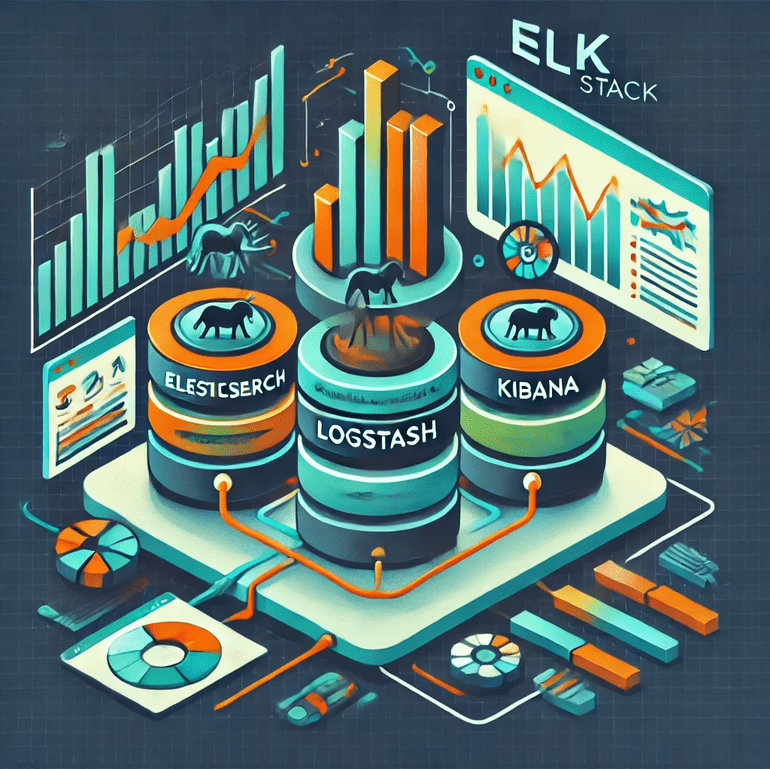In the era of digital transformation, data has become one of the most valuable assets for organizations across industries. Whether it’s understanding customer behavior, optimizing operations, or ensuring security compliance, the ability to collect, analyze, and visualize data is critical for making informed decisions. However, the sheer volume of data generated daily poses a significant challenge. This is where the ELK Stack, a powerful open-source solution for log and data analytics, comes into play.
The ELK Stack—comprising Elasticsearch, Logstash, and Kibana—is designed to help organizations collect, store, search, and visualize large volumes of data from various sources. Its flexibility, scalability, and real-time processing capabilities make it a popular choice for IT operations, DevOps, security, and business intelligence. This article delves into the key components of the ELK Stack, its benefits, and how Curate Consulting Services can assist you in finding the specialized talent needed to leverage this technology effectively.
Understanding the ELK Stack: Breaking Down Its Components
The ELK Stack is an acronym for its three main components: Elasticsearch, Logstash, and Kibana. Each of these components plays a crucial role in the data processing pipeline, working together to provide a comprehensive solution for log management and data analytics.
1. Elasticsearch: The Core Search and Analytics Engine
At the heart of the ELK Stack is Elasticsearch, a distributed, real-time search and analytics engine. Elasticsearch is designed to handle both structured and unstructured data, making it highly versatile for various use cases. It excels in providing fast, scalable, and flexible search capabilities, which are essential for organizations dealing with large datasets.
Elasticsearch’s distributed nature allows it to scale horizontally by adding more nodes to the cluster, ensuring that it can handle increasing amounts of data without compromising performance. This scalability is particularly valuable for enterprises that need to store and search through massive amounts of logs or transactional data.
For example, a financial institution might use Elasticsearch to index and search millions of transactions daily. By leveraging Elasticsearch’s powerful query capabilities, the institution can quickly identify patterns, detect anomalies, and generate reports that support regulatory compliance and fraud detection.
2. Logstash: The Data Collection and Processing Pipeline
Logstash is the data collection and processing pipeline of the ELK Stack. It is responsible for ingesting data from various sources, transforming it, and sending it to Elasticsearch for storage and indexing. Logstash supports a wide range of input plugins, allowing it to collect data from log files, databases, message queues, and other sources.
One of Logstash’s key strengths is its ability to transform and enrich data as it flows through the pipeline. This includes parsing complex log formats, filtering out unnecessary information, and standardizing data to make it suitable for search and analysis. By processing data in real-time, Logstash ensures that the information sent to Elasticsearch is clean, structured, and ready for immediate use.
Consider an e-commerce company that wants to monitor user activity on its website. Logstash can collect logs from web servers, process them to extract relevant information such as user actions, session durations, and error codes, and then send this data to Elasticsearch for indexing. The company can then use this data to analyze user behavior, identify trends, and optimize the website’s performance.
3. Kibana: The Visualization and Exploration Tool
Kibana is the data visualization and exploration tool of the ELK Stack. It connects to Elasticsearch and provides a user-friendly interface for creating custom dashboards, reports, and visualizations. Kibana allows users to explore their data interactively, search and filter it using a web-based interface, and gain insights through charts, graphs, and maps.
Kibana’s flexibility in creating visualizations makes it an indispensable tool for organizations looking to derive actionable insights from their data. Whether it’s monitoring application performance, analyzing security events, or tracking business metrics, Kibana’s dashboards provide a clear and intuitive way to present complex data.
For instance, a healthcare provider might use Kibana to create a dashboard that tracks patient admissions, treatment outcomes, and resource utilization. By visualizing this data, the provider can identify bottlenecks in patient care, allocate resources more efficiently, and improve overall service delivery.
How the ELK Stack Works: From Data Ingestion to Visualization
To understand the full potential of the ELK Stack, it’s essential to see how its components work together to process and analyze data. Here’s a step-by-step overview of the ELK Stack’s workflow:
1. Data Ingestion with Logstash
The process begins with Logstash ingesting data from various sources. This could include server logs, application logs, database records, or even data streams from IoT devices. Logstash’s input plugins support different data formats and protocols, making it easy to collect data from diverse sources.
2. Data Transformation and Enrichment
Once the data is ingested, Logstash processes it to ensure it’s ready for analysis. This involves parsing the data to extract relevant fields, filtering out unnecessary information, and enriching the data with additional context, such as geolocation or user identifiers. This step is crucial for standardizing data and making it suitable for storage in Elasticsearch.
3. Data Storage and Indexing in Elasticsearch
After processing, the transformed data is sent to Elasticsearch, where it is indexed and stored. Elasticsearch’s distributed architecture ensures that the data is stored efficiently and can be retrieved quickly, even as the volume of data grows. Elasticsearch supports full-text search and complex querying, enabling users to search through vast amounts of data in milliseconds.
4. Data Visualization and Exploration with Kibana
Finally, Kibana connects to Elasticsearch and provides a graphical interface for visualizing and exploring the data. Users can create custom dashboards to monitor key metrics, generate reports, and gain insights into their data. Kibana’s real-time capabilities allow users to track data trends as they happen, making it ideal for monitoring applications and infrastructure.
Key Benefits of the ELK Stack: Unlocking the Power of Data
The ELK Stack offers numerous benefits that make it a preferred choice for organizations looking to harness the power of their data. Here are some of the key advantages:
1. Real-time Monitoring and Alerting
The ELK Stack is widely used for real-time monitoring and alerting in IT operations. By continuously ingesting and analyzing data from servers, applications, and network devices, organizations can detect issues as they occur and respond quickly to minimize downtime.
For example, a telecom company might use the ELK Stack to monitor network traffic in real-time. If Logstash detects an unusual spike in traffic that could indicate a DDoS attack, it can trigger an alert, allowing the operations team to take immediate action and mitigate the threat.
2. Log Analysis and Troubleshooting
One of the primary use cases for the ELK Stack is log analysis. Organizations generate vast amounts of log data, which can be challenging to manage and analyze without the right tools. The ELK Stack simplifies this process by collecting, indexing, and visualizing logs, making it easier to search for specific events, identify patterns, and troubleshoot issues.
A software development team might use the ELK Stack to analyze application logs for debugging purposes. By visualizing error rates, response times, and user interactions, the team can quickly pinpoint the root cause of issues and deploy fixes, improving the overall quality of the software.
3. Security and Compliance
The ELK Stack is also a powerful tool for security information and event management (SIEM). Organizations can use it to collect and analyze security events, monitor compliance with regulations, and detect potential threats. By correlating data from multiple sources, the ELK Stack helps security teams gain a comprehensive view of their environment.
A financial services company might use the ELK Stack to monitor user activity and detect suspicious behavior that could indicate fraud. By setting up alerting rules in Kibana, the company can receive real-time notifications of potential security incidents, enabling a swift response.
4. Big Data Analytics
The ELK Stack’s scalability and flexibility make it suitable for big data analytics. Whether it’s analyzing customer behavior, tracking sales trends, or monitoring social media activity, the ELK Stack can handle large datasets and provide valuable insights that drive business decisions.
For example, a retail company might use the ELK Stack to analyze sales data from multiple stores and online channels. By visualizing this data in Kibana, the company can identify top-selling products, forecast demand, and optimize inventory management.
5. Open Source and Community Support
All components of the ELK Stack are open source, which means organizations can use and modify the software without licensing costs. Additionally, the ELK Stack has an active open-source community that contributes plugins, dashboards, and extensions, making it a flexible and cost-effective solution.
The availability of community resources allows organizations to customize the ELK Stack to meet their specific needs. For instance, a startup might leverage community-contributed plugins to add functionality to Kibana, such as new visualization types or data connectors.
Curate Consulting Services: Finding the Right Talent for Your ELK Stack Implementation
While the ELK Stack offers powerful capabilities, its successful implementation and maintenance require specialized skills. This is where Curate Consulting Services can help. We specialize in connecting businesses with top-tier tech talent, ensuring that you have the right professionals to manage and optimize your ELK Stack deployment.
Why Partner with Curate Consulting?
Expertise in Technology Talent: Our team understands the intricacies of the ELK Stack and the specific skills required to succeed with it. We can help you identify and recruit professionals with expertise in Elasticsearch, Logstash, Kibana, and related technologies.
Tailored Staffing Solutions: We offer flexible staffing solutions to meet your unique needs, whether you require full-time employees, contract-based specialists, or project-based consultants.
Streamlined Recruitment Process: Our recruitment process is designed to be efficient and thorough. We handle everything from sourcing and screening candidates to conducting interviews and onboarding, allowing you to focus on your core business.
Commitment to Quality: We are committed to delivering the highest quality talent to our clients. Our rigorous vetting process ensures that every candidate we present meets your technical and cultural requirements.
Conclusion: Unlocking the Full Potential of Your Data with the ELK Stack and Curate Consulting
In today’s data-driven world, the ability to collect, analyze, and visualize data is a critical competitive advantage. The ELK Stack provides a powerful, flexible solution for organizations looking to harness the full potential of their data. Whether it’s real-time monitoring, log analysis, security, or big data analytics, the ELK Stack has the tools you need to gain valuable insights and drive better decision-making.



